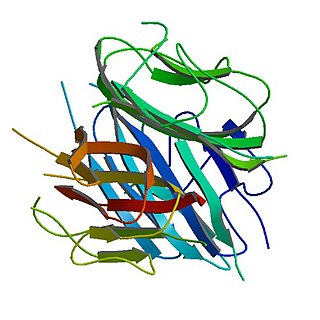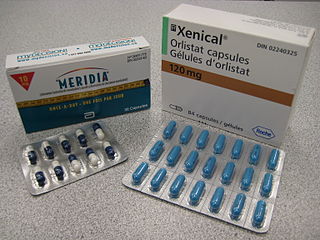Insulin resistance (IR) is a pathological condition in which cells fail to respond normally to the hormone insulin.

Leptin is a hormone predominantly made by adipose cells and enterocytes in the small intestine that helps to regulate energy balance by inhibiting hunger, which in turn diminishes fat storage in adipocytes. Leptin acts on cell receptors in the arcuate and ventromedial nuclei, as well as other parts of the hypothalamus and dopaminergic neurons of the ventral tegmental area, consequently mediating feeding.

Adiponectin is a protein hormone and adipokine, which is involved in regulating glucose levels as well as fatty acid breakdown. In humans it is encoded by the ADIPOQ gene and it is produced in primarily in adipose tissue, but also in muscle, and even in the brain.

5-HT receptors, 5-hydroxytryptamine receptors, or serotonin receptors, are a group of G protein-coupled receptor and ligand-gated ion channels found in the central and peripheral nervous systems. They mediate both excitatory and inhibitory neurotransmission. The serotonin receptors are activated by the neurotransmitter serotonin, which acts as their natural ligand.

Ghrelin is a hormone produced by enteroendocrine cells of the gastrointestinal tract, especially the stomach, and is often called a "hunger hormone" because it increases food intake. Blood levels of ghrelin are highest before meals when hungry, returning to lower levels after mealtimes. Ghrelin may help prepare for food intake by increasing gastric motility and stimulating the secretion of gastric acid.

Neuropeptide Y (NPY) is a 36 amino-acid neuropeptide that is involved in various physiological and homeostatic processes in both the central and peripheral nervous systems. NPY has been identified as the most abundant peptide present in the mammalian central nervous system, which consists of the brain and spinal cord. It is secreted alongside other neurotransmitters such as GABA and glutamate.

Anti-obesity medication or weight loss medications are pharmacological agents that reduce or control weight. These medications alter one of the fundamental processes of the human body, weight regulation, by altering either appetite, or absorption of calories. The main treatment modalities for overweight and obese individuals remain dieting and physical exercise.

Octreotide, sold under the brand name Sandostatin among others, is an octapeptide that mimics natural somatostatin pharmacologically, though it is a more potent inhibitor of growth hormone, glucagon, and insulin than the natural hormone. It was first synthesized in 1979 by the chemist Wilfried Bauer, and binds predominantly to the somatostatin receptors SSTR2 and SSTR5. It was approved for use in the United States in 1988.

The ventromedial nucleus of the hypothalamus is a nucleus of the hypothalamus. "The ventromedial hypothalamus (VMH) is a distinct morphological nucleus involved in terminating hunger, fear, thermoregulation, and sexual activity." This nuclear region is involved in the recognition of the feeling of fullness.
Nesfatin-1 is a neuropeptide produced in the hypothalamus of mammals. It participates in the regulation of hunger and fat storage. Increased nesfatin-1 in the hypothalamus contributes to diminished hunger, a 'sense of fullness', and a potential loss of body fat and weight.

Melanocortin 4 receptor is a melanocortin receptor that in humans is encoded by the MC4R gene. It encodes the MC4 protein, a G protein-coupled receptor that binds α-melanocyte stimulating hormone (α-MSH). In mouse models, MC4 receptors have been found to be involved in feeding behaviour, the regulation of metabolism, sexual behaviour, and male erectile function.

The 5HT6 receptor is a subtype of 5HT receptor that binds the endogenous neurotransmitter serotonin (5-hydroxytryptamine, 5HT). It is a G protein-coupled receptor (GPCR) that is coupled to Gs and mediates excitatory neurotransmission. HTR6 denotes the human gene encoding for the receptor.
The central melanocortin system is defined anatomically as a collection of central nervous system circuits which include:
The diet-induced obesity model is an animal model used to study obesity using animals that have obesity caused by being fed high-fat or high-density diets. It is intended to mimic the most common cause of obesity in humans. Typically mice, rats, dogs, or non-human primates are used in these models. These animals can then be used to study in vivo obesity, obesity's comorbidities, and other related diseases. Users of such models must take into account the duration and type of diet as well as the environmental conditions and age of the animals, as each may promote different bodyweights, fat percentages, or behaviors.

5-Carboxamidotryptamine (5-CT) is a tryptamine derivative closely related to the neurotransmitter serotonin.

WAY-161503 is a full agonist of 5-HT2C receptors (Ki = 3.3 nM for displacement of DOI), ~6-fold less potent at 5-HT2A receptors (Ki = 18 nM) and 20-fold less potent at 5-HT2B receptors (Ki = 60 nM). In functional studies, it stimulates calcium mobilization coupled to 5-HT2C, 5-HT2B, and 5-HT2A receptors with EC50 values of 0.8, 1.8, and 7 nM, respectively. WAY-161503 has been reported to produce dose-dependent decreases in food intake in 24-hour fasted normal Sprague-Dawley rats, diet-induced obese mice, and obese Zucker rats with ED50 values of 1.9, 6.8, and 0.73 mg/kg, respectively.

JD5037 is an antiobesity drug candidate which acts as a peripherally-restricted cannabinoid inverse agonist at CB1 receptors. It is very selective for the CB1 subtype, with a Ki of 0.35nM, >700-fold higher affinity than it has for CB2 receptors.
5-HT2C receptor agonists are a class of drugs that activate 5-HT2C receptors. They have been investigated for the treatment of a number of conditions including obesity, psychiatric disorders, sexual dysfunction and urinary incontinence.

Geniposide is a bioactive iridoid glycoside that is found in a wide variety of medicinal herbs, such as Gardenia jasminoides (fruits) . Geniposide shows several pharmacological effects including neuroprotective, antidiabetic, hepatoprotective, anti-inflammatory, analgesic, antidepressant-like, cardioprotective, antioxidant, immune-regulatory, antithrombotic and antitumoral activity. These pharmacology benefits arise through the modulating action of geniposide on several proteins and genes that are associated with inflammatory and oxidative stress processes.
Asprosin is a protein hormone produced by mammals in tissues that stimulates the liver to release glucose into the blood stream. Asprosin is encoded by the gene FBN1 as part of the protein profibrillin and is released from the C-terminus of the latter by specific proteolysis. In the liver, asprosin activates rapid glucose release via a cyclic adenosine monophosphate (cAMP)-dependent pathway.














